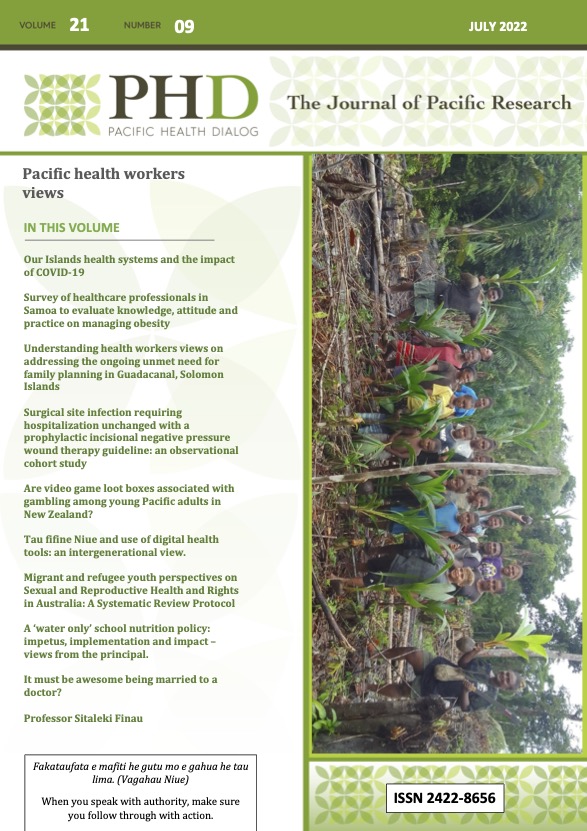Surgical site infection requiring hospitalisation unchanged with a prophylactic incisional negative pressure wound therapy guideline: an observational cohort study
Main Article Content
Keywords
negative-pressure wound therapy, surgical wound infection, caesarean section, laparotomy
Abstract
Background: Despite numerous published prospective studies, evidence to support use of prophylactic incisional negative pressure wound therapy, for obstetric and gynaecologic surgery, is conflicting.
Aim: To evaluate if wound-related presentations to hospital were reduced following introduction of a guideline promoting selective use of prophylactic incisional negative pressure wound therapy.
Methods: This was an observational cohort study. Electronic medical records were reviewed for all hospital presentations, within 30 days of primary surgery performed by laparotomy, where the responsible clinician was an obstetrician or gynaecologist. Rates of wound complications and costs associated with admission were compared pre- and post-guideline.
Results: Among all those who underwent caesarean birth (n = 2788) or gynaecologic laparotomy (n= 263), 5% presented to hospital with SSI, and 1% with non-infected wound problems. No significant reductions in SSI hospital presentations, length of stay, or readmission costs were observed post-implementation. Likewise, no improvements were observed for non-infected wound problems or a composite of SSI and non-infected wound problems.
Conclusions: This study does not support the selective approach used to direct prophylactic incisional negative pressure wound therapy. Further studies are required to better individualise risk assessment, and to determine if negative pressure wound therapy can reduce serious morbidity of SSI. When robust evidence is lacking, local outcomes should be evaluated systematically and reviewed before new treatments become standard care.
References
2. Scheck SM, Blackmore T, Maharaj D, et al. Caesarean section wound infection surveillance: Information for action. Aust N Z J Obstet Gynaecol. 2018;58:518-24.
3. Steiner HL, Strand EA. Surgical-site infection in gynecologic surgery: pathophysiology and prevention. Am J Obstet Gynecol. 2017;217:121-8.
4. Surgical Site Infection Improvement [homepage on the internet]. Wellington: Health Quality and Safety Commission [Cited 2020 Aug 8]. Available from: https://www.hqsc.govt.nz/our-programmes/infection-prevention-and-control/projects/surgical-site-infection-improvement/
5. Glass GE, Murphy GF, Esmaeili A, et al. Systematic review of molecular mechanism of action of negative‐pressure wound therapy. Br J Surg. 2014;101:1627-36.
6. Yu L, Kronen RJ, Simon LE, et al. Prophylactic negative-pressure wound therapy after cesarean is associated with reduced risk of surgical site infection: a systematic review and meta-analysis. Am J Obstet Gynecol. 2018;218:200-10.
7. Smid MC, Dotters-Katz SK, Grace M, et al. Prophylactic negative pressure wound therapy for obese women after cesarean delivery: a systematic review and meta-analysis. Obstet Gynecol. 2017;130:969-78.
8. Hyldig N, Vinter CA, Kruse M, et al. Prophylactic incisional negative pressure wound therapy reduces the risk of surgical site infection after caesarean section in obese women: A pragmatic randomised clinical trial. Br J Obstet Gynaecol. 2019;126:628-35.
9. Hussamy DJ, Wortman AC, McIntire DD, et al. Closed incision negative pressure therapy in morbidly obese women undergoing cesarean delivery: A randomized controlled trial. Obstet Gynecol. 2019;134:781-9.
10. Wihbey KA, Joyce EM, Spalding ZT, et al. Prophylactic negative pressure wound therapy and wound complication after cesarean delivery in women with class II or III obesity: A randomized controlled trial. Obstet Gynecol. 2018;132:377-84.
11. Scalise A, Calamita R, Tartaglione C, et al. Improving wound healing and preventing surgical site complications of closed surgical incisions: a possible role of incisional negative pressure wound therapy. A systematic review of the literature. Int Wound J. 2016;13:1260-81.
12. Hyldig N, Birke‐Sorensen H, Kruse M, et al. Meta‐analysis of negative‐pressure wound therapy for closed surgical incisions. Br J Surg. 2016;103:477-86.
13. Sahebally SM, McKevitt K, Stephens I, et al. Negative pressure wound therapy for closed laparotomy incisions in general and colorectal surgery: a systematic review and meta-analysis. JAMA Surg. 2018;153:e183467
14. Counties Manukau Health Women’s Health and Newborn Annual Report 2019-20. Available from: https://www.countiesmanukau.health.nz/assets/About-CMH/Reports-and-planning/Maternity/2020_CMH_maternity_Annual_Report.pdf
15. Horan TC, Gaynes RP, Martone WJ, et al. CDC definitions of nosocomial surgical site infections, 1992: a modification of CDC definitions of surgical wound infections. Infect Cont Hosp Ep. 1992;13:606-8.
16. Perla RJ, Provost LP, Murray SK. The run chart: a simple analytical tool for learning from variation in healthcare processes. BMJ Qual Saf. 2011;20:46-51.
17. Tuuli MG, Liu J, Tita AT, et al. Effect of prophylactic negative pressure wound therapy vs standard wound dressing on surgical-site infection in obese women after cesarean delivery: A randomized clinical trial. JAMA. 2020;324:1180-9.
18. Leitao Jr MM, Zhou QC, Schiavone MB, et al. Prophylactic negative pressure wound therapy after laparotomy for gynecologic surgery: A randomized controlled trial. Obstet Gynecol. 2021;137:334-41.


